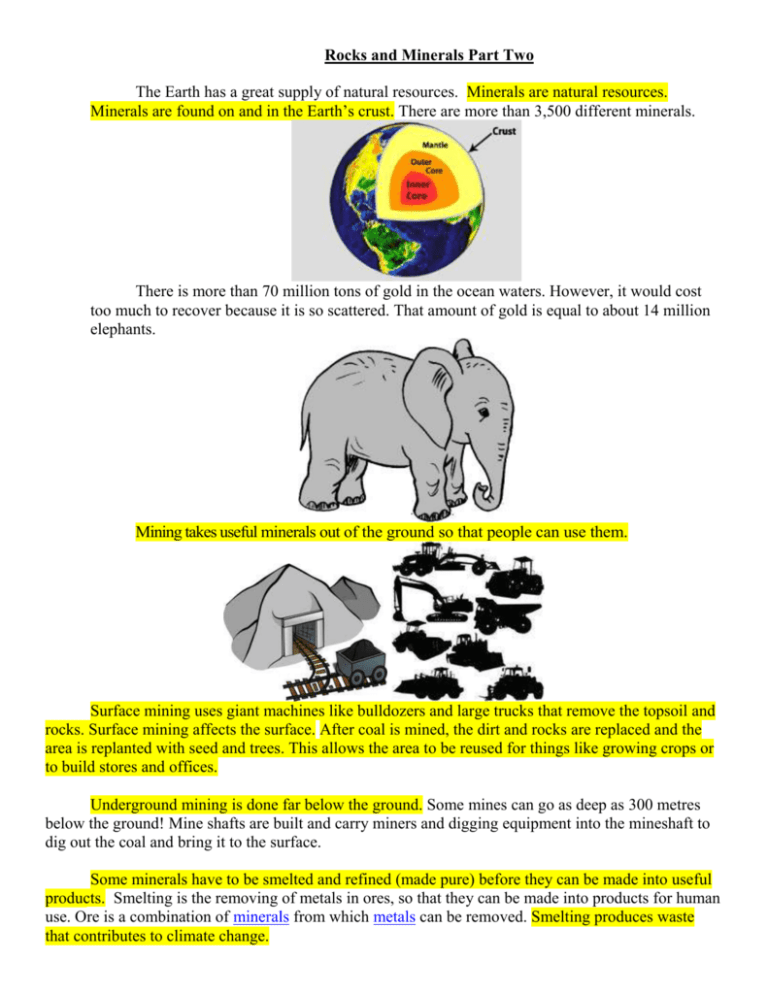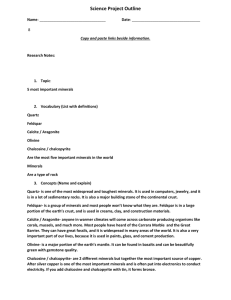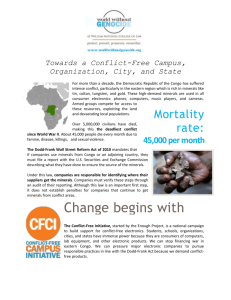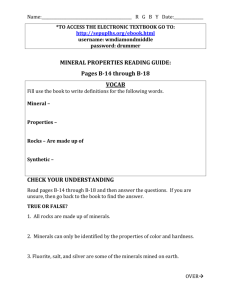Click Here To
advertisement

Rocks and Minerals Part Two The Earth has a great supply of natural resources. Minerals are natural resources. Minerals are found on and in the Earth’s crust. There are more than 3,500 different minerals. There is more than 70 million tons of gold in the ocean waters. However, it would cost too much to recover because it is so scattered. That amount of gold is equal to about 14 million elephants. Mining takes useful minerals out of the ground so that people can use them. Surface mining uses giant machines like bulldozers and large trucks that remove the topsoil and rocks. Surface mining affects the surface. After coal is mined, the dirt and rocks are replaced and the area is replanted with seed and trees. This allows the area to be reused for things like growing crops or to build stores and offices. Underground mining is done far below the ground. Some mines can go as deep as 300 metres below the ground! Mine shafts are built and carry miners and digging equipment into the mineshaft to dig out the coal and bring it to the surface. Some minerals have to be smelted and refined (made pure) before they can be made into useful products. Smelting is the removing of metals in ores, so that they can be made into products for human use. Ore is a combination of minerals from which metals can be removed. Smelting produces waste that contributes to climate change. Minerals are in nearly all of the products we use. Every person uses products made from minerals every day. Things used at home, at play, and at school come from the Earth. It takes many minerals to make something as simple as a wooden pencil. The cars that people drive, the roads that we travel, and the buildings that we live in are all made using minerals. Minerals must go through a number of steps before items can be made. 1) First, the mineral must be found! 2) After the minerals are found, they must be removed from the Earth. 3) Valuable minerals are often hidden as tiny pieces in a rock. The valuable minerals are removed from the rock. 4) Some minerals have to be smelted and refined before they can be made into useful products. 5) Products are made. Toothpaste Stove Towel Lamp Cosmetics Hairspray Clock Vacuum Carpet Dishwasher Golf Clubs Chair Refrigerator Fireplace Clock radio Batteries Sunscreen Mirror Do you know which mineral you eat every day? One person use 5.4 kilograms of salt a year on food and another 180 kilograms a year for other things. We need salt in the food we eat, but when we use too much on our roads and sidewalks it can damage our cars, water, and plants. Aluminum is used to make pop cans and trash cans. A pop can can be recycled many times. You can buy a can of pop at the store, drink the pop and place it in a blue bin. That pop can can be recycled into a new aluminum can, filled with pop, sent to a store, and sold again–all within 90 days. Recycling uses much less energy than making aluminum from ore. Clay is mined. It is used to make plates and mugs, bricks for building and kitty litter. Products that are made from clay break down similar to the way a rock does. Stone and sand are used to make concrete. Concrete is used to make buildings and roads. Making concrete uses a lot of natural resources.









